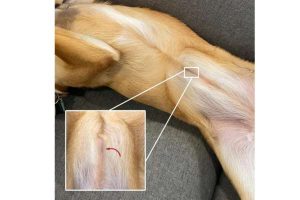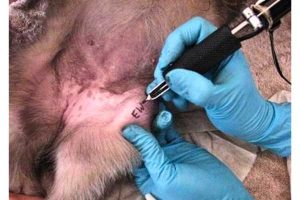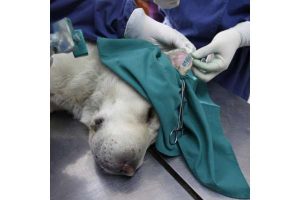Why Do Veterinarians Use Tattoos? Dogs Get Tattoo When They’re Neutered Or Spayed
Are you considering getting your dog neutered or spayed? If so, you may be wondering if they should also get a pet tattoo.
While many people are hesitant about the idea of pet tattooing, it’s actually a safe and beneficial procedure that helps protect both animals and humans.

In this article, we’ll explore why dogs get tattoos when they’re neutered or spayed, the benefits of getting one for your pup, and what risks to keep in mind.
You’ll also learn how pet tattoos can help ensure your furry friend is taken care of if he or she ever gets lost.
Ready to find out more? Let’s dive in!
Overview of Neutering or Spaying
You may be wondering why neutering or spaying is necessary for a pet’s overall health and wellness; let’s take a closer look.
Neutering or spaying your pet has many benefits, such as helping to manage population control and reducing the chances of your pet developing certain types of cancers. Additionally, it can help with behavioral issues, such as aggressive behavior, roaming, urine marking, and excessive vocalization.

Spay/neuter costs vary depending on where you are getting the procedure done but typically range from $50-200 depending on if anesthesia is required and other services related to the procedure.
The recovery process for pets after they have been spayed or neutered usually takes seven days to two weeks. During this time it is important to keep your pet calm in order to prevent any internal swelling or bleeding complications that could occur due to physical activity too soon after the surgery.
Taking care of your pet during their recovery period is also an opportunity for you to bond with them even more! It’s important that they get plenty of rest and water during this time as well as small meals throughout the day rather than one large meal at once. You should also make sure that they don’t lick their incisions too much as this could cause infections.
Overall, neutering or spaying your pets offers numerous benefits for both you and them! The cost associated with these procedures are minimal when compared to potential medical bills down the line that might arise from not doing so; plus there are many low-cost options available through local shelters and clinics if needed.
Pet recovery times can be shortened by ensuring proper care while monitoring their activity levels closely – all in all leading to a healthy happy pet living alongside you for many years!
What is Pet Tattooing?
Pet tattooing is a safe and permanent way to identify your pet, ensuring their timely return should they ever be lost or stolen. It’s a fast-growing trend in the United States as more and more pet owners are opting for the simple procedure as a means of keeping their beloved animals safe from theft or loss.
In some localities, there are even laws that require pets to be identified with tattoos. The process involves using an electronically controlled device to insert ink into the dermis layer of skin, creating an indelible mark that can include the pet’s name, address, microchip number or other information that will help reunite you with your furry friend if they’re ever separated from you.

The procedure itself is incredibly quick and straightforward and typically takes only minutes to complete – no anesthesia required! Pet tattooing does not cause any significant discomfort either; it does not require sedation or pain medication as it is inserted beneath the surface layer of skin where nerve endings don’t exist.
Furthermore, because it’s done quickly, there’s less chance of infection compared to other more invasive methods such as ear tagging or chipping. This form of pet identification may also provide peace-of-mind knowing that your four-legged family member has been permanently marked with information necessary for their safe return home if needed.
With its convenience and safety advantages over traditional methods such as dog tags or collars, pet tattooing can be an excellent choice for responsible owners who want to ensure their pet remains safe no matter what happens.
Reasons for Getting a Tattoo When Neutering or Spaying
Identifying your pet with a tattoo when they’re neutered or spayed is an easy way to ensure their safe return home, should they ever get lost. Responsible pet ownership includes making sure that your beloved furry friend has permanent identification, and pet tattooing is one of the most reliable ways to do this.
Pet microchipping can also provide important information about your pet, but tattoos can’t be removed if stolen – making them much more secure for reuniting you and your pup. Tattooing pets also helps reduce overpopulation in shelters by connecting animals with their owners before they enter the system. When owners are able to find their animals quickly, it reduces the number of animals who end up in shelters due to straying from home or being abandoned altogether.

Additionally, it prevents people from unknowingly adopting a formerly owned animal from a shelter, which could cause problems if there were any disputes between former owners and adopters. Another reason for getting a tattoo on your dog when neutering or spaying is that it acts as an additional layer of protection against theft.
It’s not uncommon for criminals to target expensive purebred pets as part of criminal activities like dog fighting rings or breeding operations, so adding a visible identifier may make them less attractive targets for these types of crimes. Having a permanent mark on your pup will also help anyone who finds them know that they have already been taken care of medically – saving time and money at the vet down the line!
Benefits of Getting a Pet Tattoo
Having a pet tattoo can provide you and your furry friend with numerous benefits, from increasing their chances of being returned home safely to providing additional protection against theft. Pet nutrition and pet insurance are just some of the ways you can benefit from having your beloved family member tattooed.
A pet tattoo helps ensure that if your pet ever gets lost, they will be able to be identified and reunited with their rightful owner. In many cases, it’s the only way for a shelter or veterinarian to determine ownership. This means that even if your pet does get away from home, there’s still hope for them to find their way back!
Pet tattoos also offer an extra layer of protection against theft. If someone were to try and steal your furry family member, the tattoo could help identify them as yours and make it more difficult for them to do so successfully. Additionally, having a visible identification mark on your pet can act as a deterrent to potential thieves in the first place!
Furthermore, getting a pet tattoo may qualify you for discounts on certain services such as vet visits or pet insurance premiums due to the increased level of security associated with it. As an added bonus, you’ll have peace of mind knowing that if anything were ever to happen to your beloved companion, they would at least have some form of identification on them, which would help increase their chances of being returned home safely!
Understanding the Risks of Pet Tattooing
When considering pet tattooing, it’s important to weigh the risks as well as the benefits – after all, a stitch in time saves nine!
Vaccination risks are one of the biggest factors to consider when deciding whether or not to get a pet tattoo. There is always a slight chance that your pet may develop an infection or allergic reaction due to their vaccinations, so it’s best to consult with your vet before getting any kind of permanent marking on your pet.
Additionally, there are also tracking concerns if you choose to opt for a microchip instead of a tattoo – this could be an issue if you ever lose or have stolen pets and need them to be tracked down.
It’s also worth noting that some states and countries require certain types of tattoos for pets that have been spayed or neutered. This is done primarily for health reasons, as animals who haven’t been sterilized can lead to overpopulation problems. If you live in an area where these laws apply, then having your pet tattooed is essential – but make sure that it is done safely by a qualified professional who understands the health implications involved.
Tattooing pets should never be taken lightly; it requires careful thought and research into both the potential benefits and risks involved beforehand. It’s important to understand all aspects of getting your pet marked before making any decisions about what type of procedure would best suit their needs.
That being said, with proper preparation and cautionary measures in place, getting a pet tattoo can provide lasting protection for both owners and their beloved furry friends alike!
See also:
My Dog Jumped After Being Spayed
Dog Gland Removal Pros And Cons
Frequently Asked Questions
What type of ink is used for pet tattooing?
You may be wondering what type of ink is used for pet tattooing.
The answer depends on the placement of the tattoo.
If it’s a visible location, such as on the ear, then non-toxic vegetable dyes are typically used to make sure your pet isn’t harmed by any chemicals or heavy metals.
On other areas of the body, permanent inks like India ink can be used to provide long-lasting results.
No matter which type of ink you choose, it’s important that your pet is comfortable and safe throughout the process.
Is pet tattooing painful for the animal?
Getting a pet tattoo can be a stressful experience, but it doesn’t have to be painful for the animal.
Pet psychology experts suggest that animals are more aware of their surroundings and sensations than we think, so it’s important to ensure that the procedure is done in a hygienic environment with the right equipment.
To minimize pain, veterinarians use special tattooing ink made for pets and use topical anesthetics or injectable sedatives to keep your furry friend as comfortable as possible during the process.
With these precautions taken, you can rest assured that your pet won’t feel any real discomfort when getting a tattoo.
Is there a specific age range for neutering or spaying that requires a pet tattoo?
Tattooing pets is a common practice for identifying them, especially after they’ve been neutered or spayed. Your vet may require this type of marking as part of their regulations, so it’s important to find out ahead of time what the requirements are.
There isn’t an exact age range that always requires pet tattooing after neutering or spaying; however, most vets prefer to do the procedure when the animal is between six and twelve months old.
Markings on your pet can provide helpful information if they ever get lost, so it’s important to talk to your vet about any necessary requirements for pet markings before undergoing surgery.
Are there any laws or regulations regarding pet tattooing?
You may be wondering about the laws and regulations concerning pet tattooing.
In many states, there are animal welfare laws that require a tattoo to be placed on animals after they are spayed or neutered in order to identify them as altered and reduce the cost implications of pet care.
However, it’s important to keep in mind that it’s illegal to remove a pet’s tattoo without authorization and proper documentation.
There are also regulations in place to ensure the safety of animals during any type of tattoo removal procedure.
Ultimately, pet owners should always consult with their veterinarian before making any decisions regarding their animal’s care.
Does the pet need to be sedated during the tattooing process?
You may be wondering if your pet needs to be sedated during a tattooing process. The answer is usually yes, as it helps keep them still and ensures their safety when the ink is applied.
Pet sedation can be administered in several ways depending on the size of the animal and other factors. This will help keep them comfortable throughout the procedure while also ensuring that ink remains in a safe location on their body.
If you’re considering getting your pet a tattoo, make sure to look into all available options for sedation before deciding.
Conclusion
You might be wondering why a dog would need to get a tattoo when they’re getting neutered or spayed.
While it may seem like an unusual practice, there are actually some important reasons behind pet tattoos.
Pet tattoos can help identify animals in case they become lost or stolen, as well as make sure that the animal isn’t bred unintentionally.
Even though pet tattooing does carry some risks, it’s ultimately beneficial for your pup.
Plus, you can give them a unique and stylish look in the process!
So go ahead and let Fido show off his new ink – he deserves it!
